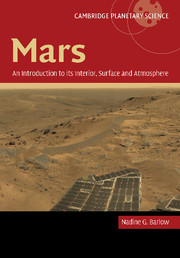Book contents
- Frontmatter
- Contents
- Preface
- 1 Introduction to Mars
- 2 Formation of Mars and early planetary evolution
- 3 Geophysical measurements and inferred interior structure
- 4 Surface characteristics
- 5 Geology
- 6 Atmospheric conditions and evolution
- 7 History of water on Mars
- 8 Search for life
- 9 Looking ahead
- References
- Appendix: Mission reports
- Index
- Plate section
- References
References
Published online by Cambridge University Press: 15 December 2009
- Frontmatter
- Contents
- Preface
- 1 Introduction to Mars
- 2 Formation of Mars and early planetary evolution
- 3 Geophysical measurements and inferred interior structure
- 4 Surface characteristics
- 5 Geology
- 6 Atmospheric conditions and evolution
- 7 History of water on Mars
- 8 Search for life
- 9 Looking ahead
- References
- Appendix: Mission reports
- Index
- Plate section
- References
- Type
- Chapter
- Information
- Mars: An Introduction to its Interior, Surface and Atmosphere , pp. 221 - 254Publisher: Cambridge University PressPrint publication year: 2008

